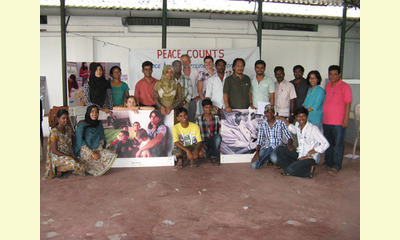|
|
Peace Counts on Tour in Kerala, India
an article by Berghof Foundation News
Video: Peace Counts
The group that travelled to Kochi in southern India to participate in the Peace Counts Training of Trainers programme proved to be as diverse as India itself: Hindus, Muslims and Christians from five states, and each with their own local language. A young law student from Kerala sat next to a social worker from a slum in Tamil Nadu. But one thing binds them together: their commitment to their role as multipliers and representatives of civil society organisations, striving towards a peaceful future for their country.

click on photo to enlarge
The five-day Training-of-Trainers programme was organised by the Berghof Foundation in co-operation with Bread for the World, a partner organisation, and INSAF (Indian Social Action Forum), a local network. Since 2009, these organisations have enjoyed close co-operation within the Peace Counts framework. This third training programme, following two previous programmes in New Delhi in 2009, has resulted in a considerable expansion of the Peace Counts network.
Through Peace Counts, multipliers become familiar with a range of peace education methods and materials, which they can use in their own work and adapt for their specific contexts. Participants come from civil society organisations, focusing on themes such as inter-religious dialogue, peace and reconciliation, justice, education, and development in slums. One component of the training programme is therefore to recognise the contributions the participants themselves can make, and indeed do make, to peace and conflict transformation.
“I particularly like that Peace Counts is based around authentic biographies of people experiencing conflict“, explained Robinson, who works for the Henry Martin Institute in Hyderabad. “It makes it much easier to communicate concepts of conflict or violence, which would otherwise seem too abstract. I will definitely be using Peace Counts in the training programmes I run in Northeast India.”
The new Peace Counts reports had a particular resonance with the participants. The story of Mateo from Colombia, who uses Hip Hop to promote alternatives to a career in drugs, was an inspiration to the young women from the Solidarity Youth Movements Kerala (SYM). They plan to set up Peace Counts workshops with youth leaders in the next few months, where Mateo’s story will be used to inspire others too.
Trainers Nadine Ritzi and Anne Romund, from the Berghof Foundation, summarised the training programme as follows: “Despite diverse backgrounds, the participants really grew together as a group. Peace Counts both inspired them and sensitised them to peace as a topic. We are thoroughly convinced that they will take the momentum gained during this week back home with them and continue their engagement with Peace Counts.“ . . .
Since 2006, Peace Counts on Tour has been travelling to conflict zones, using reports on successful peacebuilders to support and embolden those who are engaged with peace and conflict transformation in their own countries. The reports are produced by journalists and photographers from Zeitenspiegel Reportagen and Advanced Journalism Academy, the two organisations with which the Berghof Foundation co-operates to realise Peace Counts. . .
|








|
DISCUSSION
Question(s) related to this article:
Learning opportunities to foster global community, What are the important components in their design?
* * * * *
Latest reader comment:
Here are the Training Objectives and Expected Impact of the training described in the report, Young People's Retreat for Social Change.
Training Objectives
* To build understanding and trust among youth of diverse religions, spiritual expressions
and indigenous traditions;
* We work to bridge an active connection between youth participants and their communities and
to encourage youth participants to engage in meaningful service in their community.
* Strive to inspire and connect new generations of conscious, committed young leaders and to
provide them training and leadership opportunities to create a space for Peace.
* We encourage young people to explore and rediscover their cultural traditions and to deepen
roots in their community and tradition.
Expected Impact of Training
1. To prepare enable the youth from all faiths in regard to create a peaceful atmosphere within
their communities.
2. To sensitize people about human values and dignity of man irrespective of religions/faiths and
gender.
3. To empower and skilled the participants to play their role as peace and interfaith harmony actors
for the restoration of human life/dignity.
4. The practical support to direct beneficiaries and trainee would boost up the confidence and self
respect among their respective communities.
5. Ultimately the individual will have a sense of their own personal potential to be an active peace
builder and strive for living an ethical life within diverse situations.
6. To develop on the ground local relevant humanitarian projects that further peace.
7. To link to a global network of like minded and like hearted youth who are standing aligned with
these values.

|
|









